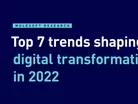Mulesoft: Top 7 digital transformation trends shaping 2022

Being at the forefront of digital transformation, CIOs must stay ahead of ever-changing digital trends to meet rising demands and accelerate their digital transformation. This report covers the top seven technology trends that will determine the business landscape in 2022.
Read this report to learn:
- How IT and business teams are adapting to the future of work built on connected, hybrid experiences.
- How CIOs and IT leaders are staying on top of these trends and enabling innovation.
- Recommendations to use these trends to fuel digital transformation in your organisation.
The future of work will be built on connected, hybrid experiences
Successful organisations are built on the productivity and dedication of their employees. So when the pandemic forced offices around the world to close, employers were understandably nervous. What followed has been dubbed the “largest work-from-home experiment” in history. It has reshaped the meaning of the “workplace” and transformed employee expectations about their digital experiences at work in 2022 and beyond.
The composable business matures
If the first 10 years of the millennium were all about the web, and the following decade was driven by the huge advances in mobile technology, then the 2020s will be a period of seamless digital experiences. To make this a reality, organisations will need to think carefully about how they drive enhanced agility, which will lead to a new era of event-driven architectures and composable businesses in 2022.
The rise of the business technologist
As the pressure to deliver seamless digital experiences for customers and employees grows, so does the demand on IT departments. The volume of digital initiatives doubled during the pandemic, making it even more difficult for already stretched teams to keep up with the needs of the business. IT teams also found themselves pulled away from innovation projects more regularly during the crisis, to provide critical support needed to ensure “business as usual.” In 2022, business technologists will relieve some of this pressure by working alongside IT teams to accelerate innovation. Gartner found that those organisations that successfully enable business technologists are 2.6x more likely to accelerate digital business outcomes. However, to do so, they will need the right tools at their disposal.
Hyperautomation unlocks digital value
Digital transformation was already an urgent business priority before the pandemic, but now, it could be the difference between success and failure. This is why automation will increasingly be key to unlocking productivity, transforming employee and customer experiences, and rapidly launching new products and services in 2022. Automation will be a fundamental driving force for the modern digital enterprise, rather than being used in piecemeal projects. Organisations want to automate anything that can be automated. Welcome to the world of hyperautomation.
Security-by-default is a must-have
Business and technology leaders have realised that their ability to accelerate digital transformation is increasingly dependent on whether they can become a composable enterprise. That means creating the ability for IT and business teams to assemble and reassemble pre-packaged business capabilities (PBCs) to meet the insatiable demands for digital agility, efficiency, and scale. However, the speed of digital innovation that this introduces also invites cybersecurity risk. If not managed effectively, this risk could expose organisations and/or their customers to major financial and reputational damage. As such, the platforms used to manage composable building blocks like reusable APIs in 2022 will need to be secure-by-default.
The rise of hybrid, distributed ecosystems adds complexity
IT and business leaders agree that the ability to create seamless digital experiences for both employees and customers is key to the success of modern organisations. Many have identified that the best way of making this a reality is to adopt a composable enterprise architecture, enabled by APIs. This helps teams within the business securely access data and digital capabilities to create more connected experiences, and drive faster innovation. However, the IT foundation underpinning this ambitious digital transformation is increasingly fragmented and complex. With hybrid and multi-clouds now the norm, how do organisations manage integration across multiple environments? In 2022, universal API management will come to the fore as organisations seek answers to this question.
A single source of truth becomes key to the data-driven business
The world is witnessing a data explosion. In 2020 alone, over 64 zettabytes (ZB) were created, and this volume is expected to grow at a rate of 23% up to 2025, according to IDC. Yet for organisations looking to integrate, analyse, and act on this data, things aren’t getting any easier. IT complexity, proprietary systems, and a lack of strategic direction all provide their own challenges. To be a successful data-driven organisation in 2022, organisations must break down silos across the enterprise to create a single source of truth. Only then can business leaders look to machine learning and data analytics to make sense of all their data for enhanced decision making.
- 10 things to know about Ping An, China's largest insurerCorporate Finance
- PwC China to train 25,000-strong workforce on generative AITechnology
- JD.com brings back retired Yan Xiaobing to run retail armLeadership & Strategy
- Why Singapore continues to be the smartest city in AsiaTechnology



